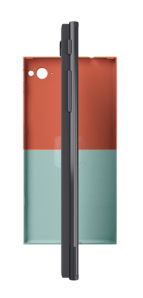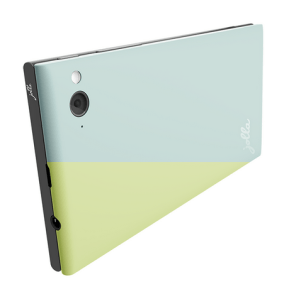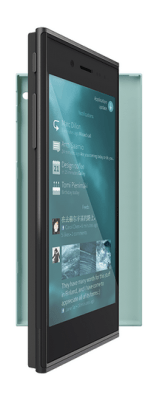Jolla, a Finnish startup formed in response to Nokia’s decision to ditch MeeGo in favour of Windows Phone, has finally taken the wraps off the smartphone hardware that will be paired with its “unlike” Sailfish UI. Being a startup is challenging enough in any business sector but Jolla is seeking to compete in the fiercely competitive smartphone space, going up against giants Samsung and Apple who hold the majority of the market in a pincer grip. So it’s hard not to dismiss their efforts as too late. But it’s a lot harder to accuse them of doing too little.
Jolla’s strategy for fighting the mobile industry’s Goliaths is all about standing out by doing things different. Today’s hardware underlines how this startup is hoping to disrupt the concept of a single flagship device — such as the Samsung Galaxy S4 — that’s hankered after and owned by millions yet with only a little variation in case colourings to tell the difference between each one.
In seeking to break down software homogeneity with its Sailfish UI and a business model that encourages working with third parties to develop new types of smartphone experience that loop in others’ data, Jolla is also taking aim at hardware commoditisation via a cross-over feature in its debut device that it’s calling the Other Half. The Other Half refers to removable hardware shells that snap on to the back of the handset and can be changed and customised by the user. But the feature goes further than interchangeable shells — which is not at all new, dating back in spirit to early Nokia mobile phones of the 1990s with their removable facias, and more recently to a device like Nokia’s Lumia 820, which has a coloured and swappable backplate.
Jolla’s Other Half isn’t just decoration but links to the software on the handset — using an unconfirmed bridging technology that sounds to my ear like NFC — allowing content on the phone to be tied to the addition of a new shell, or even for new physical features to be incorporated and supported.
Jolla’s Marc Dillon, now head of software but until recently CEO, gave some examples of how the Other Half feature could be used — noting that this is about opening up the back of the device for others to come in and augment.
 “You have the processor side of the device, the power side, the engine, and then the Other Half is about adding to that. This is a new kind of media where it could be anything from your favourite artist could release their latest album on the other half of the Jolla device, and then when the user buys this they have a physical thing from their favourite artist then when they snap it on to the other half of their Jolla device, then everyone can see it, that they support and love their artist and then on the inside they could get the content. They could get maybe special content, that could only be released in this format like videos or links to websites or tickets or special offers, things like that but because of this interface between the two halves,” he told TechCrunch.
“You have the processor side of the device, the power side, the engine, and then the Other Half is about adding to that. This is a new kind of media where it could be anything from your favourite artist could release their latest album on the other half of the Jolla device, and then when the user buys this they have a physical thing from their favourite artist then when they snap it on to the other half of their Jolla device, then everyone can see it, that they support and love their artist and then on the inside they could get the content. They could get maybe special content, that could only be released in this format like videos or links to websites or tickets or special offers, things like that but because of this interface between the two halves,” he told TechCrunch.
“It can not only be media, it can be very simple things — so maybe you have a colour palette, so when you go out of an evening you might have a different colour depending on your outfit and that colour then carries through to the software updating the Ambience of the device. So you might have — if you have a green dress, you might have a green device and then you have green icons and green Ambience [Sailfish UI theme] on your phone. But it can also be more interesting — you can add features. Like the camera is a good example, the native camera of course has a flash but maybe you’re going to a party and you want to have a big flash so you can take pictures in the dark at a nightclub. So really the imagination is the only limit here.”
“Instead of having a device with some bulky things attached to it or some things sticking out the side of it to extend the capabilities of the device, or to add content, we’re giving a new way for users to actually design and co-create with us new ways of using the device,” Dillon added.
“Of course we will be offering a choice of Other Halves for the user to buy but this is a place where we want to see others get involved. Designers can design Other Halves for the device, engineers or hackers or techies can design new interfaces and maybe add physical hardware features that they wish they had on their device but might have a smaller market than to deserve having a whole entire device,” he said. “We talked about 3D printing them today. So it could be those kinds of things, but really we’re offering a new kind of interface for a device so that people can really take their imagination, and I believe there will be a lot of third parties and a lot of people who have a lot of great ideas in order to help you use the Other Half of the Jolla device.”
The Other Half may be a bit of a clumsy name but it’s a savvy move that taps into the custom hardware trend that’s growing off the back of the rising profile of 3D printing. That said, it does of course remain to be seen how much interest Jolla can spark for others to get involved in co-creation with only one device to its name and that device not launching for another six months. It will need enough traction to get the co-creation party started.
The idea to link the hardware and software has been part of Jolla company discussions and plans since the beginning, according to Dillon. “It’s been something that we’ve been planning and working towards the whole time. The Ambience was a hint of how this can come together,” he noted, adding: “Hardware like many things, it’s become a commodity, so the problem with commodities is it generally forces things down — things become kind of lowest common denominator… We set out to make the greatest device that we could, and we understood that the software and the user experience is key because that’s where the value comes from in the device and the hardware is the realisation of that, it’s a productisation of the software.
“So we kind of took this tack, then of course the hardware has to be fantastic it has to support the software and support the user and be something the user can be proud of and my belief is that when people see the Jolla device they want to see what’s inside.”
“This iteration, the direct stuff here, has been about a year in development. It started getting really good for me about six months ago and I’ve been using the device for a while now, and it’s really started to feel fantastic, when the hardware and the software have come together. They were done by the same designers and the same people so it has been kept in mind that the two go together, that the two have a synergy the entire time. We’ve had a roadmap the entire time as well so we’ve had a set of hardware specifications to work with,” he added.
It’s worth flagging that Jolla is not the only mobile maker to take an interest in 3D printing and custom hardware, even if it’s taken that further by creating a link between custom hardware and phone content. 3D printing is something Nokia has done with the Lumia 820 shell, for instance. Dillon said Jolla may also look to open source the 3D design of the Other Half, telling TechCrunch “I could see that happening”.
Asked specifically about the bridging technology between the hardware shell and the software, Dillon declined to give specific details, saying: “There’s a number of options here but there is a connection between the Other Half and the software. And of course all of that needs to be open as well.”
Asked whether the device will launch in the U.S. he said Jolla is looking at other markets but opting for Europe and China first. “We’re starting with Europe and China and we will be extending to other markets as we go. We’re in the delivery phase at the moment so we’re building the infrastructure, and the logistics in order to be able to deliver and care for the users of the device, and we’re of course going to look at other markets as we go.”
“It’s the target to get the Christmas market in Europe, Chinese New Year. That’s the big milestones,” he added. “The most important thing is we come out with a fantastic product… When we’re shipping at the end of the year if it’s a fantastic product then it’s really going to resonate and I think we’re really going to have a lot of demand.”
